5 Hanging Succulent Plant Variety
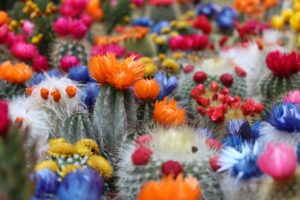
Succulents originated in dry arid desert locations, the word succulent comes from the Latin word “sucus, meaning juice or sap.” The leaves of succulents tend to be thick, fleshly, and plumpy, the reason for this is to store water. It’s believed that during the 15th century Christopher Columbus on his route to India came across some of these succulents (cacti) some of which he took and presented to Queen Isabella of Spain.
There are said to be more than 10,000 succulents worldwide, many of these succulents are being crossbred by nurseries around the world. Some succulents are edible and there are others that are used for aesthetics. Some succulents are used medically to treat many health issues some of which include stomach aches, common cold, burns, sore throat, cuts, skin disease, dry itch skin, etc… Below we will be discussing Hanging Succulent Plants.
1. Donkey’s Tail
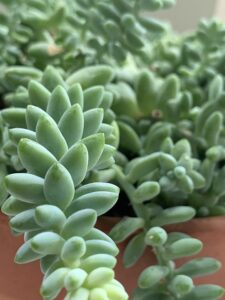
Donkey’s tail (Sedum morganianum) commonly called burro’s is a popular house plant that’s drought-tolerant, this perennial produces blue-green foliage trailing stems that can grow up 24-inches. Donkey’s tail thrives best in direct sunlight when watering allow the soil to dry out thoroughly before watering again. The leaves on the donkey’s tail are said to be ” non-toxic to humans and pets”
2. Monkey Tail Cactus
Monkey tail Cactus (Cleistocactus colademononis) stems are greenish-yellow, on the stems are hair-like soft white spines protruding downwards covering the entire stem. Even though the appearance of this succulent may seem inviting be very careful because looks can be deceiving the monkey tail can deliver a painful prick.
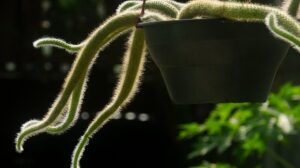
A single plant can have three to five stems that branch at the bottom, the monkey tail can tolerate drought conditions and prefers soil that’s well-drained. Monkey tail performs best in bright indirect sunlight. “The flesh of the monkey tails is said to be poisonous” keep this plant away from children and pets. During the spring and summer months ( growing season) water your monkey tail weekly. However it’s best to check the soil before watering, the soil should be allowed to dry out before watering again.
3. String of beads
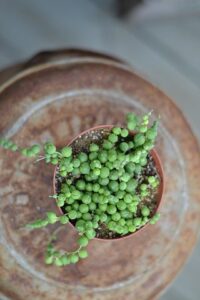
String of beads (Senecio herreianus) is a trailing succulent that has fleshy oval shape leaves, this succulent is commonly called string of tears. The stems can grow one to several feet in length Like all plants in the Senecio genus. The soil should be a well-drained soil or cactus potting mix, allow the soil to dry out before adding more water. Another sign that your string of beads is thirsty is when the beads show signs of wilt or begin to draw inwardly. Keep in direct sunlight, string of beads are toxic to humans, cats, and dogs.
4. Stonecrop
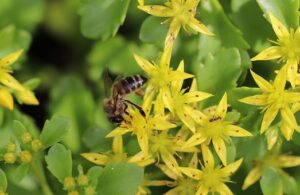
Stonecrop (genus Sedum) commonly called sedum or orpine, genus of 600 plants species of succulent plant in the family Crassulaceae. This succulent beauty grows up to 7-10 inches tall. Stonecrop produces a thick clump of fleshly foliage. The soil of the stonecrop should be loose, loamy, sandy, or gravelly soil with good drainage.
Stonecrop grows best in indirect bright sunlight, allow the soil to dry out before giving your stonecrop another drink of water, soils that are too wet can lead to root rot. Stonecrops are “generally considered to be non-toxic to humans and pets.”
5. Queen of the night
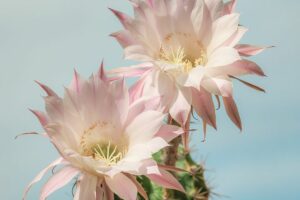
Queen of the night (Epiphyllum oxypetalum) commonly the Dutchman’s pipe cactus, princess of the night, or queen of the night produces white sweet-scented circular-shaped flowers with narrow petals. The growth of this garden beauty is flat and long with spineless branches that are modified stems which become pendulous and drape making this succulent the perfect fit for a hanging basket.
The ideal soil for this queen to thrive and show off her beauty is soil that’s airy and well-drained, this garden beauty does not like wet feet and should be watered once every two weeks. Filtered sunlight or morning sunlight is what the queen of the night needs to perform her best, queen of the night is said to be “non-toxic to dogs, cats, and horses”
The final word on hanging succulent plants
There you have it, these are five succulent plants among many that are sure to rock your world, what I love about these garden beauties is the ease of care. If you are always on the go but want a garden that’s easy to maintain then I recommend giving two or more of these hanging plants a try. You will be so happy that you did as you connect with nature by gardening about the ground.
About the author
Norman loves being in the garden, both at home and for his job....
he is 'Natures Little helper' being outdoors, growing his vegetables and flowers from an early age.
Now having spent over 22 years in the profession he want to give some of his knowledge to others...
his vast array of hints and tips you will find scattered over this site will help you no end growing plants in your garden.

Great info, I love plants, I think they make your home a so much better place. It’s incredible the change of one room before and after you put a few plants as decoration.
Succulent plants are one of my favourites, they is a great variety of them and they require minimum care, they are perfect for busy people haha.
These plants are amazing and so easy to maintain that is another reason that makes them so great. Thanks so much for stopping by and commenting.
English is not my first language. Maybe that’s the reason why I just learned in this article that the word succulent could describe the plants found in dry location. Now that been said, I love the queen of the night. What a beautiful plant! I have heard that it prefers some shades. I guess that’s why the plant is named the queen of the night.
Succulents are pretty amazing and are so easy to maintain, there are so many of them which gives a great variety to choose from I am so happy to help.